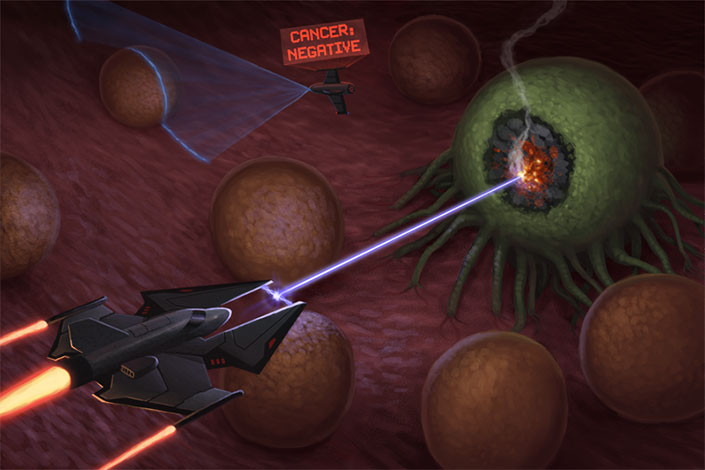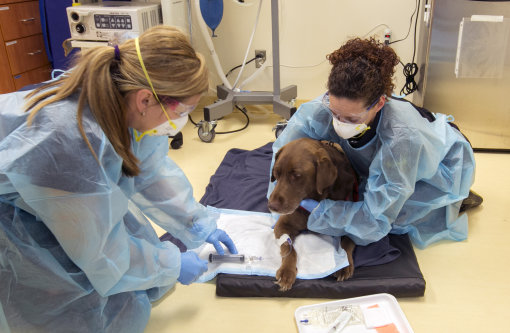The word chemotherapy often elicits negative images in the minds of most people – hair loss, vomiting, and pain. Therapies meant to attack cancers can have the unfortunate effect of making patients sick. While this is often the case for humans receiving chemotherapy, the same is not true for our fur babies!
The majority of pets do not experience significant side effects from chemotherapy.
Of course each dog or cat is an individual, and thus can respond differently to cancer treatments. This week I discuss chemotherapy, including potential side effects and home safety. Remember board-certified veterinary oncologists (aka: cancer specialists) are available and ready to partner with you and your family veterinarian to ensure your pet receives the best anti-cancer therapies. Happy reading!
Chemotherapy Point #1: How does it work?
Anti-cancer drugs kill cells that are growing and/or dividing, as unprecedented growth and division are hallmark characteristics of cancer cells. These medications have different mechanisms of action, and attack cancer cells in different ways, including:
- Causing damage to the cell’s genetic composition
- Preventing cells from dividing
Chemotherapeutic drugs can’t differentiate cancer cells from healthy ones. Therefore some normally growing and dividing cells of the body are potentially sensitive to anti-cancer treatments. Happily these normal tissues are generally able to repair themselves, and permanence of injury induced by chemotherapy is rare.
Chemotherapy Point #2: Administration
Given the wide variety of anti-cancer drug treatments, the route and frequency of administration of these medications is variable. Some medications are administered by mouth at home while others are given as injections in a vein or under the skin in a hospital on an outpatient basis. Slow intravenous infusions of some anti-cancer drugs may be necessary, requiring pets to spend the day in the hospital with their oncology teams (who, by the way, tend to thoroughly spoil them!). Chemotherapy treatments are usually repeated once weekly to every few weeks.
Chemotherapy Point #3: Potential Side effects
A major concern of pet parents is whether a pet will become sick while receiving chemotherapy. Remember cancer cells tend to change frequently, and anti-cancer drugs target changing cells. However as mentioned earlier the body also has normal cells that change frequently, including hair follicle cells, bone marrow cells, and cells that line the gastrointestinal tract. Thus chemotherapy side effects tend to result from an interaction in one of these locations. Your pet’s cancer team should explain all potential side effects of your pet’s anti-cancer treatments.
Pets do not commonly lose their hair, although this is possible (especially in breeds whose hair continuously grows). More commonly a shaved area may regrow slowly or hair may grow back a different color. Some cancer drugs may cause nausea, and your pet’s oncology team will likely provide anti-nausea medications preemptively. Prior to each chemotherapeutic treatment, a non-invasive blood test called a complete blood count (CBC) is typically performed to ensure red blood cells, white blood cells, and platelets are present in adequate numbers. If cell numbers are too low, treatment may be postponed, a lower drug dose may be used, and/or an affected may be prescribed a course of an antibiotic to help reduce the incidence of an opportunistic bacterial infection.
An oncology team should reevaluate chemotherapy patients who are lethargic and/or have poor appetites (with or without vomiting and diarrhea) for more than 24 hours. Similarly a veterinarian should reexamine as soon as possible patients who lick excessively at chemotherapy injection sites. Steroids (e.g.: prednisone, dexamethasone) are used in many chemotherapeutic protocols, and these drugs commonly cause pets to urinate larger volumes more frequently and to drink more. Thus pets receiving steroid therapy should, in general, have access to fresh cool water at all times.
As mentioned earlier, a patient’s white blood cell count drops below normal after some chemotherapeutic treatments, and then returns to normal by the next treatment. Typically this expected decrease does not cause a problem; however if the white blood cell count falls too low, the body can have difficulty fighting infection. Signs to watch for include lethargy, vomiting, diarrhea, poor appetite, and a fever. When properly hydrated, your pet’s gums should be moist and shiny, and the skin should bounce back when gently lifted; please note these findings are somewhat subjective and vary according to age and panting. Some chemotherapeutic drugs can cause damage to tissue if they get outside the vein and come in contact with other tissues, such as muscle and skin.
Chemotherapy Point #4: Home Safety
It is important to minimize exposure to chemotherapy, and common sense precautions should be taken. For example, if you are administrating chemotherapy by mouth at home, the following steps are appropriate:
- Ensure children and pets do not have access to the drugs
- Do not eat, drink, or chew gum when giving the medication
- Do not crush or break the pills
- Wear unpowdered latex gloves when handling anti-cancer medications (unless allergic to latex). Dispose of the gloves promptly, and wash your hands thoroughly after administration
- Return gloves and empty vials to your pet’s oncology team for proper disposal
A small amount of the chemotherapy is normally excreted in the urine and/orfeces. One should wear gloves for handling of feces or urine (i.e. if they have an accident in the house/apartment) and/or soiled items. Additionally, soiled bedding and linens should be washed in standard fashion. Floors, carpets, and countertops should be cleaned with appropriate detergents.
Should one’s skin be accidentally exposed to a chemotherapeutic drug, the affected area should be washed thoroughly with soap and warm water. If the skin becomes irritated, evaluation with one’s personal physician is recommended. Those who are pregnant and/or have immature/compromised immune systems should avoid contact both with chemotherapy drugs and pet (and pet’s waste) for 72 hours after chemotherapy administration.
The take-away about chemotherapy in dogs and cats…
Learning a pet is living with cancer is news no pet parent ever wants to receive. The prospect of chemotherapy to treat the cancer is daunting given families are rightfully concerned about potential side effects and their fur baby’s welfare. There are many different types of chemotherapeutic agents, and consultation with a board-certified veterinary oncologist (or internal medicine specialist) is strongly recommended to ensure the most appropriate treatments are prescribed for your fur baby.
To find a board-certified veterinary oncologist or board-certified veterinary internal medicine specialist, please visit the American College of Veterinary Internal Medicine.
Wishing you wet-nosed kisses,
cgb



